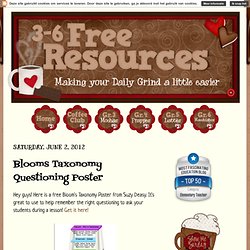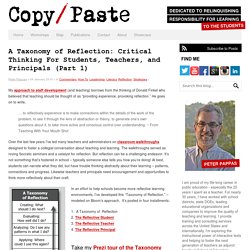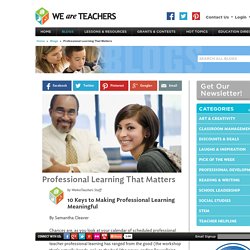

Checklista lärstrategier. ELEVHJÄLP häfte med mallar. ELEVHJÄLP häfte med mallar. Frågebatteri. Mall årsplanering. File_download. Blooms Taxonomy Questioning Poster. Hey guys!

Here is a free Bloom's Taxonomy Poster from Suzy Deasy. A Taxonomy of Reflection: A Model for Critical Thinking. My approach to staff development (and teaching) borrows from the thinking of Donald Finkel who believed that teaching should be thought of as “providing experience, provoking reflection.”

He goes on to write, … to reflectively experience is to make connections within the details of the work of the problem, to see it through the lens of abstraction or theory, to generate one’s own questions about it, to take more active and conscious control over understanding. ~ From Teaching With Your Mouth Shut Over the last few years I’ve led many teachers and administrators on classroom walkthroughs designed to foster a collegial conversation about teaching and learning. The walkthroughs served as roving Socratic seminars and a catalyst for reflection. But reflection can be a challenging endeavor. In an effort to help schools become more reflective learning environments, I’ve developed this “Taxonomy of Reflection.” – modeled on Bloom’s approach. 1.
Take my Prezi tour of the Taxonomy. Professional Learning That Matters. 10 Keys to Making Professional Learning Meaningful By Samantha Cleaver Chances are, as you look at your calendar of scheduled professional learning days, you aren’t overcome with excitement.

Traditionally, teacher professional learning has ranged from the good (the workshop that’s actually hands-on), to the bad (the never-ending PowerPoint presentation), to the ugly (remember that one presenter…). But, as the Common Core State Standards become the norm, the new standards and the expectations around problem solving and critical thinking are prompting a new look at teacher development. In the process, more districts and schools are thinking of ways to make professional learning meaningful and engaging. The biggest challenge in teacher development isn’t teaching teachers something new, but ensuring that knowledge and skills are applied in the classroom.
Diskussionsunderlag-bild.pdf. Mitt öppna klassrum. Jag blev så inspirerad av Malin Larssons klassrumsregler, så jag gjorde egna till mitt klassrum. Det blev en enorm spridning på sociala medier då många fick inspiration av detta precis som jag. Upprinnelsen till bilderna kommer från Tommy Lucassi som var med i ett radioprogram. Här hittar du hans regler som är riktade till pedagoger samt de han har i sitt klassrum. Hej då ”lydnadskultur” och välkommen ”eget ansvar” för att eleverna ska utveckla sitt bästa jag.
Examples of learning intentions. The learning intention is expressed in terms of knowledge, understanding and skills, and links directly with the relevant curriculum document.

The design of learning intentions starts with the answers to these questions. What do I want students to know? What do I want students to understand? What do I want students to be able to do? A certain challenge exists for teachers in translating the knowledge, understanding and skills of a published curriculum into learning intentions whose language is accessible to their students, but time spent on this preliminary step is in itself excellent professional learning. Some schools have made this 'unpacking' of the curriculum a focus of teacher meetings. Learning intentions that focus on knowledge Thinking about the different kinds of knowledge, and being specific about the kind of knowledge that is required in a particular situation, will help teachers design their learning intentions.They consider, for instance, Learning intentions that focus on skills.
Klassrumsstrategierbruntext.jpg (JPEG Image, 2424 × 1878 pixels) - Scaled (42%) The Other 21st Century Skills: Educator Self-Assessment. Chartkamp–I think I understand what you are saying, but in any scenario, someone, or something will spur the impetus for learning to occur.

We could have a toddler go about and learn the world from scratch, but I don’t think anyone would say that is as efficient and as effective as a “parent” facilitating, or at least providing for a safe environment. And the better the parent, the more effective the toddler will be at contributing to the learning within the community as he/she progresses. Can you describe what you mean by informal learning? I can take that to be exploratory, on your own, as equals, not in a classroom, and so many more ways. Take the place, school, out of the equation. Educational Technology and Mobile Learning: A Very Good Checklist for Assessing 21st Century Learning Skills. January 29, 2015 Here is another great resource from Dr.

Jackie Gerstein, one of our favourite EdTech bloggers. Jackie designed this beautiful chart featuring 12 attributes and skills that teachers should tend to in their instruction. You can use it as a self-assessment checklist to help you evaluate your teaching practice. What I like the most about this chart is the fact that it emphasizes the social and affective component in learning, something which is often overlooked in today’s digitally-focused learning paradigms. These mechanical skill-based and market-oriented paradigms reduce students to ‘cheerful robots’ and view pedagogy as ‘merely a skill, technique, or disinterested method’ to teach pre specified subject matter' (Giroux, 2011). Jackie's set of attributes featured in this chart chime in with Giroux's view of education as a way of producing citizens who are 'critical, self-reflective, knowledgeable and willing to make moral judgements and act in a socially responsible way.'